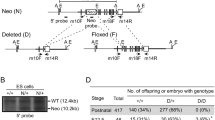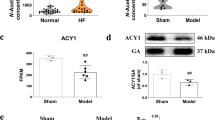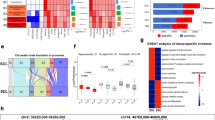Abstract
We examined the histochemical characteristics of soleus muscle in the angiotensin-converting enzyme (ACE) gene (Ace in mice, ACE in humans) knockout mice. Serial sections of soleus muscle of wild-type (Ace+/+, n=20) and heterozygous mutant (Ace+/-, n=24) mice were stained for myosin adenosine triphosphatase activity to identify different muscle fiber types. Capillaries were visualized by amylase-periodic acid-Schiff staining. ACE activity in the serum and gastrocnemius muscle was higher in male mice than in female mice. Female and male Ace+/- mice had markedly lower ACE activity in the serum and the gastrocnemius muscle than did female and male Ace+/+ mice, respectively. In both male and female mice, the composition of fiber types (type I and IIa) did not differ significantly between Ace+/+ and Ace+/- mice. There was no significant gender difference in capillary density. Ace+/- mice had significantly more capillaries around type IIa fibers (5.44±0.18 vs. 5.01 ±0.13, p<0.05) than Ace+/+ mice. The differences in the number of capillaries around type I fibers and in the number of capillaries around per fiber (capillary:fiber ratio) between Ace+/- and Ace+/+ mice were not significant (p<0.1). There was no significant difference in the mean cross-sectional area occupied by one capillary and the number of capillaries per fiber area between Ace+/+ and Ace+/- mice. In conclusion, knockout of the Ace gene in mice increased capillary density, as expressed by the mean number of capillaries around type IIa fibers. This finding suggests a possible mechanism for the cardioprotective effects of ACE inhibitors.
Similar content being viewed by others
Article PDF
References
Kem DC, Brown RD : Renin—from beginning to end. N Engl J Med 1990; 323: 1136–1137.
Dragovic T, Minshall R, Jackman HL, Wang LX, Erdos EG : Kininase II-type enzymes. Their putative role in muscle energy metabolism. Diabetes 1996; 45 ( Suppl 1): S34–S37.
Montgomery H, Clarkson P, Barnard M, et al: Angiotensin-converting-enzyme gene insertion/deletion polymorphism and response to physical training. Lancet 1999; 353: 541–545.
Danser AH, Schalekamp MA, Bax WA, et al: Angiotensin-converting enzyme in the human heart. Effect of the deletion/insertion polymorphism. Circulation 1995; 92: 1387–1388.
Rigat B, Hubert C, Alhenc-Gelas F, et al: An insertion/deletion polymorphism in the angiotensin I-converting enzyme gene accounting for half the variance of serum enzyme levels. J Clin Invest 1990; 86: 1343–1346.
Myerson S, Hemingway H, Budget R, et al: Human angiotensin I-converting enzyme gene and endurance performance. J Appl Physiol 1999; 87: 1313–1316.
Gayagay G, Yu B, Hambly B, et al: Elite endurance athletes and the ACE I allele—the role of genes in athletic performance. Hum Genet 1998; 103: 48–50.
Montgomery HE, Marshall R, Hemingway H, et al: Human gene for physical performance. Nature 1998; 393: 221–222.
Woods D, Hickman M, Jamshidi Y, et al: Elite swimmers and the D allele of the ACE I/D polymorphism. Hum Genet 2001; 108: 230–232.
Williams AG, Rayson MP, Jubb M, et al: The ACE gene and muscle performance. Nature 2000; 403: 614.
Brooke MH, Kaiser KK : Muscle fiber types: how many and what kind? Arch Neurol 1970; 23: 369–379.
Shono N, Mizuno M, Nishida H, et al: Decreased skeletal muscle capillary density is related to higher serum levels of low-density lipoprotein cholesterol and apolipoprotein B in men. Metabolism 1999; 48: 1267–1271.
Zhang B, Tanaka H, Shono N, et al: The I allele of the angiotensin-converting enzyme gene is associated with an increased percentage of slow-twitch type I fibers in human skeletal muscle. Clin Genet 2003; 63: 139–144.
Shiuchi T, Cui TX, Wu L, et al: ACE inhibitor improves insulin resistance in diabetic mouse via bradykinin and NO: Hypertension 2002; 40: 329–334.
Toblli JE, DeRosa G, Rivas C, et al: Cardiovascular protective role of a low-dose antihypertensive combination in obese Zucker rats. J Hypertens 2003; 21: 611–620.
Takeshita S, Tomiyama H, Yokoyama N, et al: Angiotensin-converting enzyme inhibition improves defective angiogenesis in the ischemic limb of spontaneously hypertensive rats. Cardiovasc Res 2001; 52: 314–320.
Rakusan K, Cicutti N, Maurin A, Guez D, Schiavi P : The effect of treatment with low dose ACE inhibitor and/or diuretic on coronary microvasculature in stroke-prone spontaneously hypertensive rats. Microvasc Res 2000; 59: 243–254.
Fabre JE, Rivard A, Magner M, Silver M, Isner JM : Tissue inhibition of angiotensin-converting enzyme activity stimulates angiogenesis in vivo. Circulation 1999; 99: 3043–3049.
Silvestre JS, Bergaya S, Tamarat R, et al: Proangiogenic effect of angiotensin-converting enzyme inhibition is mediated by the bradykinin B2 receptor pathway. Circ Res 2001; 89: 678–683.
Ebrahimian TG, Tamarat R, Clergue M, et al: Dual effect of angiotensin-converting enzyme inhibition on angiogenesis in type 1 diabetic mice. Arterioscler Thromb Vasc Biol 2005; 25: 65–70.
Scheidegger KJ, Nelissen-Vrancken MH, Leenders PJ, et al: Structural adaptation to ischemia in skeletal muscle: effects of blockers of the renin-angiotensin system. J Hypertens 1997; 15: 1455–1462.
Reneland R, Haenni A, Andersson PE, Andren B, Lithell H : Skeletal muscle angiotensin-converting enzyme and its relationship to blood pressure in primary hypertension and healthy elderly men. Blood Press 1999; 8: 16–22.
Krege JH, John SW, Langenbach LL, et al: Male-female differences in fertility and blood pressure in ACE-deficient mice. Nature 1995; 375: 146–148.
Tian B, Meng QC, Chen YF, et al: Blood pressures and cardiovascular homeostasis in mice having reduced or absent angiotensin-converting enzyme gene function. Hypertension 1997; 30: 128–133.
Fitzsimons RB, Hoh JF : Myosin isoenzymes in fast-twitch and slow-twitch muscles of normal and dystrophic mice. J Physiol 1983; 343: 539–550.
Tsika GL, Wiedenman JL, Gao L, et al: Induction of beta-MHC transgene in overloaded skeletal muscle is not eliminated by mutation of conserved elements. Am J Physiol 1996; 271: C690–C699.
Krege JH, Kim HS, Moyer JS, et al: Angiotensin-converting enzyme gene mutations, blood pressures, and cardiovascular homeostasis. Hypertension 1997; 29: 150–157.
Ando S, Tamai S, Nishikawa H : Effectiveness of fluorogenic substrates for angiotensin-converting enzyme. Peptide Sci 2003: 343–346.
Lanzillo JJ, Stevens J, Dasarathy Y, Yotsumoto H, Fanburg BL : Angiotensin-converting enzyme from human tissues. Physicochemical, catalytic, and immunological properties. J Biol Chem 1985; 260: 14938–14944.
Ramchandran R, Sen I : Cleavage processing of angiotensin-converting enzyme by a membrane-associated metalloprotease. Biochemistry 1995; 34: 12645–12652.
Meng QC, Balcells E, Dell'Italia L, Durand J, Oparil S : Sensitive method for quantitation of angiotensin-converting enzyme (ACE) activity in tissue. Biochem Pharmacol 1995; 50: 1445–1450.
Hagaman JR, Moyer JS, Bachman ES, et al: Angiotensin-converting enzyme and male fertility. Proc Natl Acad Sci U S A 1998; 95: 2552–2557.
Wei CC, Tian B, Perry G, et al: Differential ANG II generation in plasma and tissue of mice with decreased expression of the ACE gene. Am J Physiol Heart Circ Physiol 2002; 282: H2254–H2258.
Sugawara T, Fujii S, Akm Zaman T, et al: Coronary capillary remodeling in non-insulin-dependent diabetic rats: amelioration by inhibition of angiotensin converting enzyme and its potential clinical implications. Hypertens Res 2001; 24: 75–81.
Takai S, Jin D, Sakaguchi M, Miyazaki M : Significant target organs for hypertension and cardiac hypertrophy by angiotensin-converting enzyme inhibitors. Hypertens Res 2004; 27: 213–219.
Achard J, Fournier A, Mazouz H, et al: Protection against ischemia: a physiological function of the renin-angiotensin system. Biochem Pharmacol 2001; 62: 261–271.
Author information
Authors and Affiliations
Corresponding author
Rights and permissions
About this article
Cite this article
Zhang, B., Shono, N., Fan, P. et al. Histochemical Characteristics of Soleus Muscle in Angiotensin-Converting Enzyme Gene Knockout Mice. Hypertens Res 28, 681–688 (2005). https://doi.org/10.1291/hypres.28.681
Received:
Accepted:
Issue date:
DOI: https://doi.org/10.1291/hypres.28.681
Keywords
This article is cited by
-
Genes for Elite Power and Sprint Performance: ACTN3 Leads the Way
Sports Medicine (2013)
-
The angiotensin converting enzyme insertion/deletion polymorphism alters the response of muscle energy supply lines to exercise
European Journal of Applied Physiology (2013)
-
Angiotensin-converting enzyme gene polymorphism is associated with type 2 diabetes: a meta-analysis
Molecular Biology Reports (2010)



